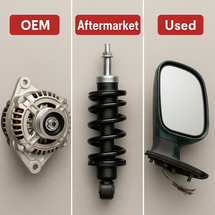31st Jul 2025
Understanding the Difference Between OEM, Aftermarket, and Used Car Parts
When it comes to replacing car parts, you’ll likely come across three main options: OEM (Original Equipment Manufacturer), aftermarket, and used parts. Each comes with its own price tag, performance expectations, and risks.
So how do you know which one is right for your vehicle? Let’s break it down.
What Are OEM Parts?
OEM parts are produced by the same manufacturer that made the original parts in your car. If you own a Vauxhall Astra, for example, an OEM part is one built by or for Vauxhall to match their original specifications.
✅ Pros:
-
Guaranteed fit and compatibility
-
Backed by manufacturer warranty
-
Consistent quality
❌ Cons:
-
Most expensive option
-
Limited availability for older models
Best for: Drivers who want peace of mind, especially after major repairs or if the car is under warranty.
Reference: RAC explains OEM parts as “the gold standard for matching factory specs.” (rac.co.uk)
What Are Aftermarket Parts?
Aftermarket parts are made by third-party companies, not affiliated with the original carmaker. They often serve the same function as OEM parts but may vary in materials, fit, and quality.
Aftermarket suppliers range from premium brands like Bosch or Brembo to low-cost, generic manufacturers.
✅ Pros:
-
Often cheaper than OEM
-
Wide variety of options
-
May improve performance (in upgraded versions)
❌ Cons:
-
Variable quality — some great, some unreliable
-
May void manufacturer warranty
-
Fitment may not be exact
Best for: Budget-conscious drivers or DIY mechanics confident in their knowledge.
Reference: Auto Express highlights that “while some aftermarket parts perform well, others are far below OEM standards.” (autoexpress.co.uk)
♻️ What Are Used Car Parts?
Used parts are salvaged from previously owned or end-of-life vehicles. These parts may be OEM or aftermarket, but they’ve been removed, tested, and resold—often at significant discounts.
Many professional scrap yards like DRS Car Parts test used parts and offer return policies.
✅ Pros:
-
Lowest cost — save up to 80%
-
Often OEM-quality
-
Environmentally sustainable
-
Available for discontinued models
❌ Cons:
-
Limited lifespan (depending on wear)
-
No universal warranty
-
Stock availability can vary
Best for: Drivers on a budget, eco-conscious consumers, or anyone with an older car not worth costly repairs.
Reference: The Green Parts Directory promotes used parts as “a vital part of the UK’s circular economy” (greenpartsdirectory.com)
Comparison Table
| Feature | OEM | Aftermarket | Used (Salvage) |
|---|---|---|---|
| Price | £££ | £–££ | £ |
| ✅ Fit & Compatibility | Exact match | Varies | Usually exact (OEM) |
| Quality | Manufacturer standard | Ranges from poor to great | Depends on inspection |
| ♻️ Environmental Impact | Medium | Medium | ✅ Low (recycled) |
| Warranty | Yes (usually) | Sometimes | Rare (or short) |
| Availability | Dealerships only | High | Varies by part & vehicle |
Which One Should You Choose?
Here’s a simple guide:
| Situation | Best Option |
|---|---|
| Your car is under warranty | OEM |
| You’re on a tight budget | Used or Aftermarket |
| You want to upgrade performance | Premium Aftermarket |
| You’re replacing a basic part (e.g. mirror, trim) | Used or Aftermarket |
| Your car is 8+ years old | Used (OEM) |
Where to Buy
-
OEM: Dealerships, certified service centers
-
Aftermarket: Auto parts retailers, Amazon, Euro Car Parts
-
Used: Trusted scrapyards, recyclers like DRS Car Parts, and certified dismantlers
✅ Final Thoughts
Whether you’re repairing on a budget or aiming for manufacturer perfection, the right type of part depends on your needs. Don’t just assume “new” is better—used OEM parts often outperform cheap aftermarket options, and they help reduce waste too.
Got questions about part compatibility?
Contact DRS Car Parts — we’ll help you match the right part by reg.

